The Chodówki Forest
A forest between Miechów and Charsznica, Borough of Miechów, Miechów District, Małopolskie VoivodshipType of place
A forestInformation about the crime
The Register of crimes and killing sites mentions the following events in the Chodówki forest:
- In 1942 the military policemen shot to death 70 Jews from Charsznica. Names of the victims have not been established. Their bodies were buried at the site of execution.
- In 1942 the military policemen shot to death approx. 600 Jews. Their bodies were buried at the site of execution.
The Chodówki forest became a killing site of people from Żarnowiec, Wolbrom, Działoszyce, Skalmierzyce and Charsznica.
In the late 1960s Kraków Regional Commission for the Examination of German Crimes in Poland was investigating murders in the Miechów District committed by Friedrich Schmidt, the deputy of Kreishaumptman. The case file contains testimonies of Charsznica residents who witnessed the “expulsion” of their Jewish neighbours:
Czesław R.: “Jews from Charsznica were gathered on the square in Charsznica and after the triage, young Jews were taken to Miechów and older ones rushed in the direction of Miechów through the village of Chodów. It’s been said that while ushering Jews, Germans were shooting them. The Germans were in a cart and they were shooting from it. It’s been said that all elderly Jews where shot before they reached the end of the village of Chodów. Their corpses were thrown into roadside ditches. Bodies of the murdered Jews were later gathered and buried in the Chodówki forest.” (Ds 1/69 p. 20-21)
Halina D.: “The gathering point for Jews was next to our house. I saw through the window Jews – men, women and children – being evicted from whole Charsznica and beaten. German military policemen and Jewish militia men were ushering them. Then several carts arrived. The carts filled with Jews left quite quickly – elders, women and children had to run behind. I saw German military policemen shooting these Jews who didn’t run fast enough. It was a horrifying scene. Gathering and exporting Jews took about 2 hours, maybe longer. […] The next day after the massacre I went on my motorbike to Miechów and saw many bloodstains on the road stretching up to the forest near Chodów. This forest was called Chodówki. […] I heard from the local residents that the Jews expelled from Charsznica were shot to death in the Chodówki forest. Some time later I saw a grave there.” (Ds 1/69 p. 25-26)
On 7 May 2014 we interviewed several residents of Miechów about the execution in the Chodówki forest.
Interview no 1 (two interviewees)
Person 1: During the war my father had two jobs. He had a side job in a private mill but his main work was in a locksmith’s workshop. This workshop was opposite a casino where Germans used to dine. And because they had constant problems with their locks and keys, they often visited the workshop. My father often went to the Gestapo or the police station to repair locks.
During the liquidation of ghettos in Miechów, Działoszyce etc. Jews were brought to Miechów, among other places. Most of them were killed on the spot, whereas in Chodówki they killed Jews who came from Miechów and those who were brought to Miechów.
Person 2: But [Jews] from Miechów weren’t liquidated in Chodówki.
P1: My father told me that executions lasted several days. Carts were coming in. And also trains – Germans used trains. There was a rail track that connected Charsznica and Chodów with Skalmierz and Działoszyce. In Kazimierza Wielka they loaded them into carriages…
My father told me that he saw them for the first time when he was called to the police station to repair several locks. They [Germans] lost keys and Jews were squashed in that place. I will show you where. Our blue policemen were guarding them. They were waiting for their turn. It looked like that: farmers’ carts would arrive and would take them [Jews] to Chodówki. Some of them were transported in cars but mostly in carts. Mayors were ordered to send carts, they had no choice. They would stop near the monument where only one military policeman would guard them. Only one. The other one would take them to a place where they undressed, they had to leave all their clothing, including underwear. Then they were ushered to the previously dug ditches where the execution was carried out. My father told me that he worked at the police station when the executions had just started and there were still many Jews left. Among them there were many young men. He would tell them: “I’ll leave you a blade – you’ll saw through the bars and run away.” Because they were not particularly guarded. Of course, they couldn’t just leave because they could be shot but it was loud and messy there. Very messy, for the German standards. People were hungry, tired and nervous – they felt something bad was happening. There were small children too so there was a lot of crying and hushing and guards were swearing. But they refused [to go.] They said: “Where would we go?”
Question: Which year was your father born?
P1: 1917. He was about 23 years old during the war.
Q: You said that Jews from Miechów weren’t killed there. So who was?
P2: Those who were brought in. And Jews from Miechów were taken to Auschwitz. Because there was railway here so they could load Jews [on the trains.] Others were brought in by the narrow-gauge railway.
Q: Do you think that your father’s account confirms the number of 600?
P1: Maybe even more. Because the executions lasted several days. Several carts came every day and they didn’t do only one trip a day because it was a short distance.
Q: And who dug the ditches into which they were throwing the bodies?
P1: Germans ushered people… Mayors were obliged [to provide people] and someone from the German military police certainly supervised it. All the ditches were prepared. So it wasn’t like that they would bring people and then dig. It was a well-organised operation.
Q: What season was it and which year?
P1: It was 1943… From what my father told me, it was 1942 or 1943.
Q: How many ditches were there?
P1: There were two ditches – quite wide, long, rounded. They placed the bodies in them. When they saw the bodies lying in disarray, they would call several Jews and order them to place the bodies evenly and then they would shoot them. And that was how it went. But they had to undress first. They [the Germans] took away all the jewellery and got rid of all the documents. And they forced other Jews to carry children and the infirm. They had to walk 100-150 metres. Meanwhile, at the gathering points they would shoot anyone who fainted. Such was a disposition. These people were dead weight for them.
Interview no 2 (interviewee: Mrs S.)
Mrs S.: There were Jews corralled here, brought in from somewhere. They were hungry. They [Germans] tormented them. When they [Germans] gathered all [Jews] they wanted, they took them to Chodówki. The whole village was crying when they were taking them. They went screaming and crying and telling us to stay safe with God. Terrible. Later on, we heard gunshots. They [Germans] ordered everyone to undress completely. If someone had something – money, rings… – they had to leave it and go. A ditch was already dug for them but I can’t remember by whom. It was very deep. When they approached it, they were shot. Those who were shot straight away didn’t have to suffer. But those who were shot badly… when people were called to bury the ditches, the soil was moving because [some of them] were still alive.
Q: How many days did the executions last?
Mrs S.: I can’t remember. One day I think and then the burying was in the evening.
Q: Behind the cabbage field there is a monument that reads “600 Jews”. Do you think there were so many of them?
Mrs S.: Probably more. But the monument is closer. The grave is deeper [at the back.]
Q: Do you remember names of any Jews that were killed?
Mrs S.: I don’t remember any Jews but I do remember people who looked after them – rescued them and hid them. In Siedliska they killed the whole Baranek family. There was a grandma in this family. They used to have this old oven for baking bread and the grandma hid in it. They [Germans] said they would shoot everyone if they didn’t find the grandma. The grandma heard everything. She came out and said she agreed to be shot. People said her hair went white in two hours. I don’t remember the year of these executions but it was cold.
Q: In how many ditches were they buried?
Mrs S.: One was large and the other a bit smaller. One Jew was very brave. He had a blade, he cut a German and ran away. They shot after him but he escaped to Siedliska. Poles gave him some clothing. He survived but I don’t know where he went later.
Q: Who covered the graves with soil?
Mrs S.: The locals. The mayor had to gather people.
Q: Those Jews that were killed… where were they from?
Mrs S.: I know there was a married couple from Charsznica and their son wanted to pee. They [Germans] ordered him to get off and when he did, they shot him. A woman two doors away from us wanted some water and they shot her too.
Q: Who was killed in Chodówki – elders, young people, families?
Mrs S.: Mostly families. There was a young Jewish girl, we went to school together. Her father owned a tailor’s shop. Apparently, they shot her in Miechów. She was very pretty.
Interview no 3 (interviewee – Mieczysław Sz.)
Mr Sz.: Older people told me [it was] at the turning. My father said so and my neighbour too. My father didn’t like to talk about it. He told me generally that Jews were killed and buried there. He was 10-11 years old then so maybe he didn’t remember too well. When you pass the chapel and the old rail tracks, there are ditches that look unnatural.
Q: How many ditches have you heard of?
Mr Sz.: I’m not sure. Just in general…
Q: There is the number 600 written on the monument. What do you think?
Mr Sz.: Probably more.
Q: Where did these Jews come from?
Mr Sz.: As far as I know, from Charsznica. My father told me they were led through this road. And they were killed by this road. They came from Sławoszów, Skalmierz, this area.
Q: Did they walk or were they driven?
Mr Sz.: As far as I know, they were rushed on foot. Whole families, all Jews from the village, there were no rules. Everyone from Charsznica – rich or poor. If someone was rich, he was promised he would be able to buy himself out and then he was taken away anyway.
Q: Did you hear how long these executions lasted?
Mr Sz.: I don’t know exactly but surely longer than one day. Several days but I don’t know how many. They were brought from other places so they wouldn’t know what was going on. Whether the Jews from Charsznica were killed in the forest or were taken to Miechów, I don’t know. My dad showed me these places. We used to go picking mushrooms but in general it was all forgotten. No one wanted to remember but everyone knew.
Interview no 4
Q: How long did the executions last?
Interviewee: One day, I think. My husband told me that when he was going back from the field he saw it… and it made him sick. He saw them being ushered, they walked on foot. If someone was weak, they [Germans] would shoot them – and throw into a ditch. Later the bodies were taken away.
Q: How many Jewish graves could be in Chodówki?
I: I don’t know. I saw one but I can’t tell you if there are more.
Q: What year was it?
I: 1943 or 1942. When guards were doing the round-up people shouted: ‘Run away, run away!’ Because people in the village knew. But they didn’t want to run away. They mostly had no place to run away to. It was difficult. People [Poles] had families, they were scared.
Interviee no 5 (interviewee: Julianna Sz.)
Q: You used to have Jewish neighbours…
Mrs Sz.: Yes, for example my friend. I used to live up there. Also in Zagorzyce but that was my family home and this one is my husband’s.
Q: Was Lewek solely a farmer or had he done something else as well?
Mrs Sz.: He traded. He was a small merchant in leather. He didn’t have a field. He was poor, he wasn’t rich. He didn’t have his own house. He used to live in a rented house. Before that, he lived in Miechów, also in a rented property. He lived with his family. He had a wife and two twin daughters. When they started taking Jews to the ghetto, he escaped Miechów and came to live in Zagorzyce where he stayed for a while. But here, as everywhere, they also took people to the ghetto so he went further, to Charsznica, because many Jews lived there. There was one called Herszla, he used to come to my mother. So he went there with his children. But in Charsznica they also started gathering Jews, they were taking them on carts. Germans with dogs were guarding them. They brought them to Chodówki – not only this family, there were many of them from Charsznica. And they [Germans] ordered them to get off near the forest. His wife got off with their daughters but they didn’t order Lewek to get off. He stayed on the cart because he was a young, strong man. He was maybe 45 years old. They shot his wife and children in front of his eyes. They took him but I don’t know where. Probably to a work camp. I can’t remember his first name but his daughters were called Riwcia and Malka.
Q: Did someone tell you this or did you see it?
Mrs Sz.: No, [I know] what’s been told. All young people went to the forest to look. It was 1942, I think.
Q: What season was that? Was it snowing?
Mrs Sz.: There was no snow. It was in the summer, I think.
Q: Did the executions in Chodówki last one day or longer?
Mrs Sz.: One day. They brought them from the ghetto in Charsznica but I heard that also from Miechów.
Q: Do you remember any Jewish families, any names?
Mrs Sz.: I do because I went to school here. There was a Jewish girl called Ajzensztajn. She was so pretty and so nice. There was also Rubinka – she had a shop. Her surname was Powica. I went to her shop, I even bought a coat from her. Those killed in Siedliska were called Czajkowski and Wajcmann. They were hidden by the Baranek family. They were all from Miechów. I knew them.
Q: Do you know how many ditches there were? Because we found three.
Mrs Sz.: I don’t know that. You know, this monument was moved. Because the place of execution was a bit lower where the arable field is now. The man who cultivated the field moved it. Now he cultivates cabbage there.
Commemoration
The site of the grave has been marked with a symbolic wooden matzevah put up as a part of the “30 matzevahs in 30 days” project in September 2017 – its objective was to mark places of the Holocaust in southern and eastern Poland. The partner of the project was the American Matzevah Foundation.

IDENTIFICATION OF THE GRAVE BASED ON NON INVASIVE RESEARCH
During site locations in 2014-2017, the exact location of mass graves (GPS: N50°22.545′ E019°59.239′) was highly likely to be determined. This place was indicated by the local resident. The results of GPR survey confirmed numerous ground disturbances occurring in three indicated locations, reaching a depth of approximately 1.20 – 1.40 m.
The LIDAR survey very clearly shows the indicated places. These are three long ditch-shaped depressions in the sizes: 1. width approx. 2.0 m, length approx. 50,0 m; 2. Width approx. 2.0 m, length approx. 45.0 m; 3. width approx. 2.0 m, length 27.0 m.
The aerial photography query for this area wasn’t ordered.
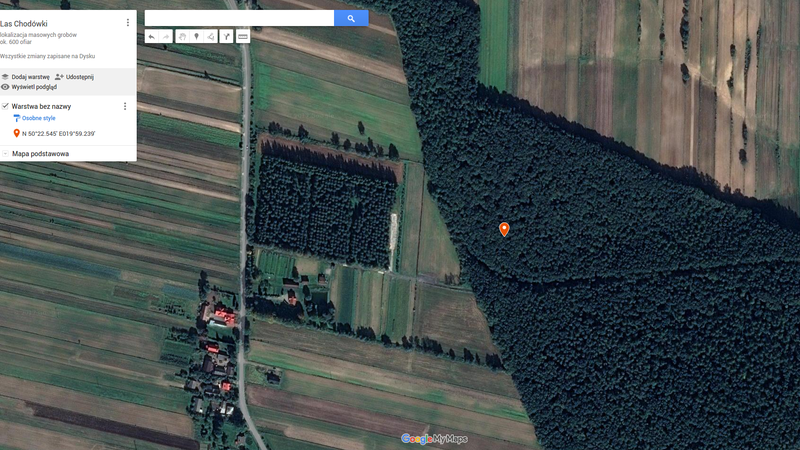 Las Chodówki fotografia satelitarna 1e
Las Chodówki fotografia satelitarna 1e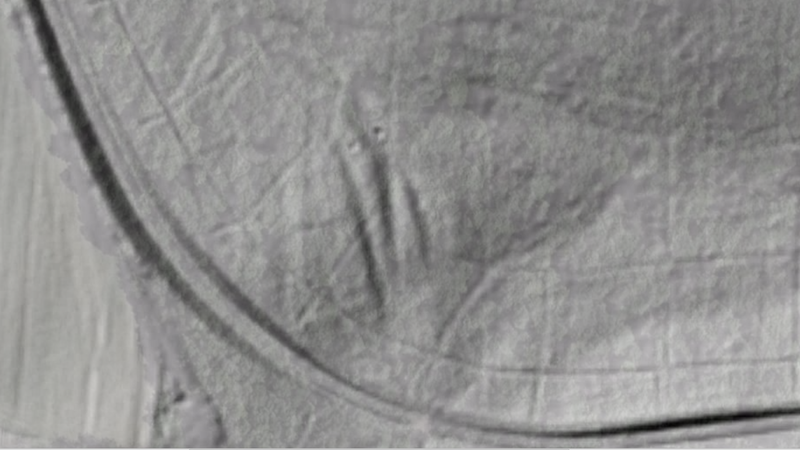 Las Chodówki lidar 1e
Las Chodówki lidar 1e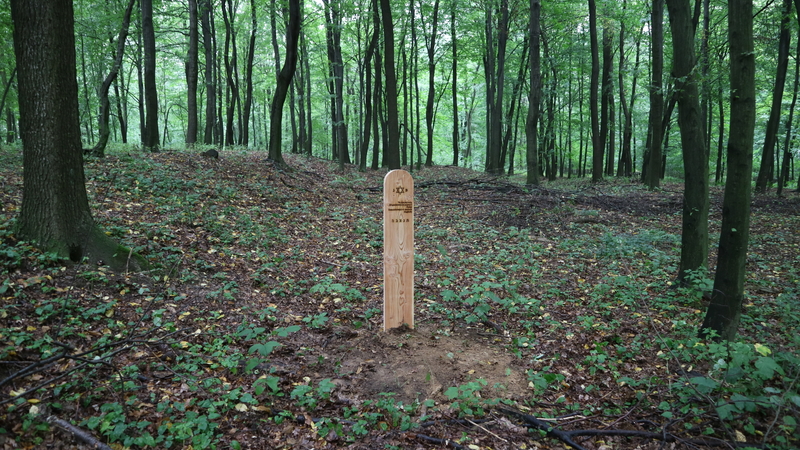 Las Chodówki fotografia 1 lokalizacji
Las Chodówki fotografia 1 lokalizacji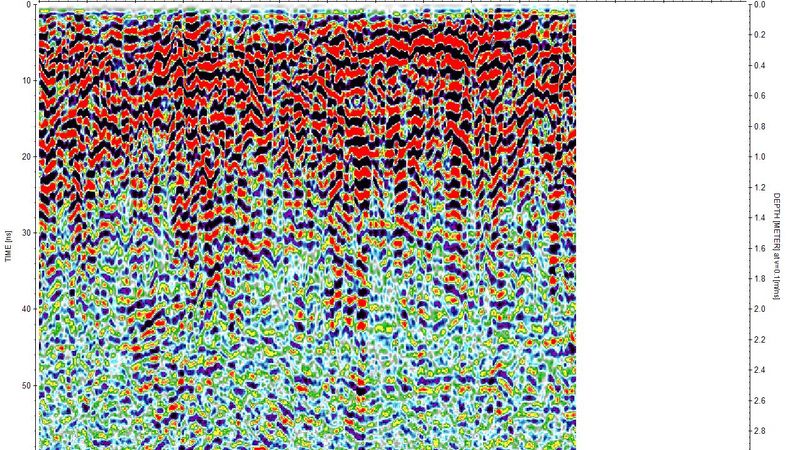 Las Chodówki CHO10001
Las Chodówki CHO10001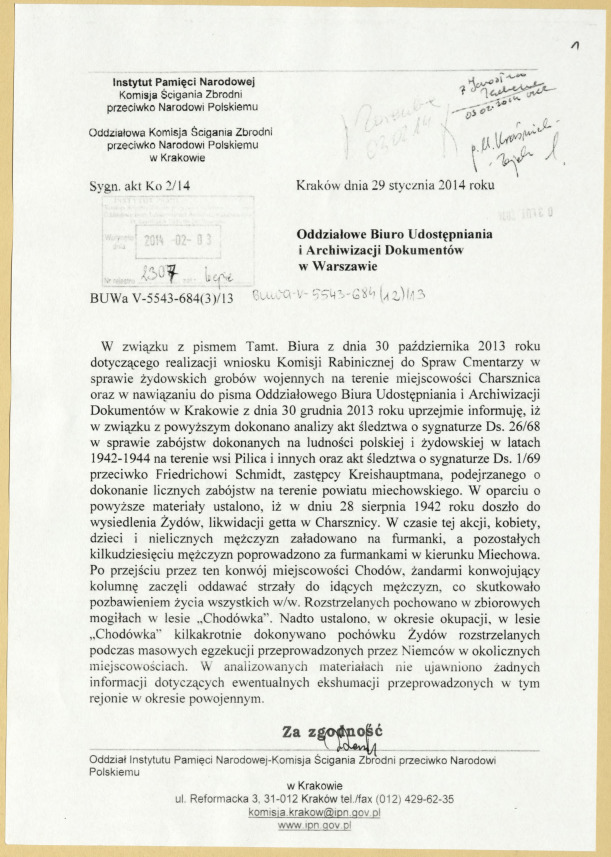 List do Oddziałowego Biura Udostępniania i Archiwizacji Dokumentów w Warszawie
List do Oddziałowego Biura Udostępniania i Archiwizacji Dokumentów w Warszawie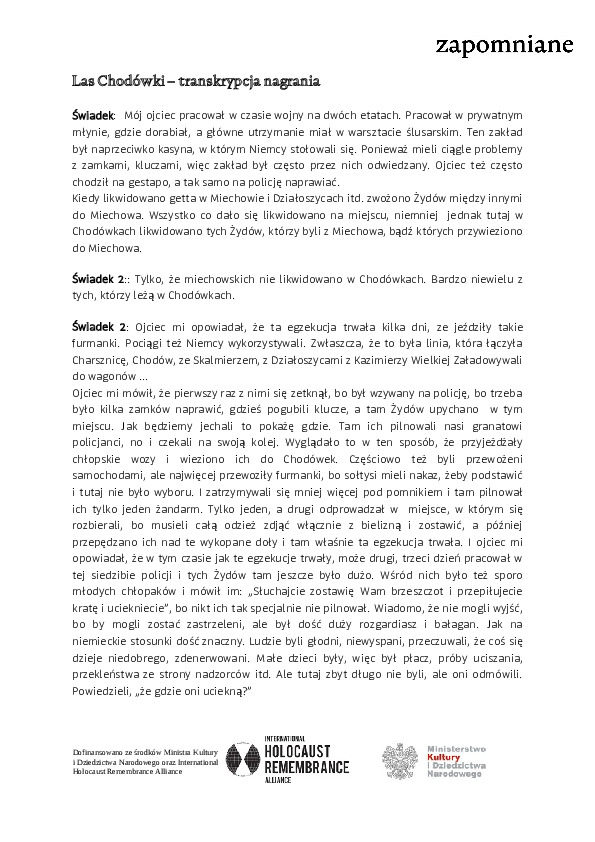 Las Chodówki- transkrypcja nagrania
Las Chodówki- transkrypcja nagrania